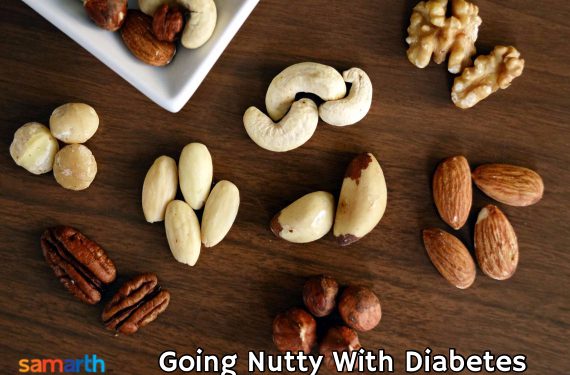The title is a bit quirky, and it does not in any way mean that one actually goes nutty with diabetes! But, diabetes is one of the severe health conditions that Indian Healthcare system has been dealing with for quite some time now. Did you know that 109 million Indians will be affected with diabetes by 2035 as per certain published reports in this regard? Almost a million Indians die every year due to diabetes and related complications. Hence, we cannot afford to take it easy or brush it under the carpet as just another lifestyle disease.
However, the good news is that diabetes also happens to be one of those diseases, that can be managed easily, with diet and lifestyle changes. With a little discipline, one can easily lead a happy and healthy life, despite having diabetes. And what better way to do it than going nutty! Yes, you heard it right, nuts are good for diabetes J
Why nuts?

Join Now >
Most nuts come loaded with health benefits because of a high level of nutrients and beneficial fats. The natural unsaturated fats in the nuts, support cell growth and protects our organs. The nuts are also rich in protein, fiber, antioxidants, Vitamins, folate, thiamine, carotenoids, and essential minerals like magnesium and potassium. All these qualities make nuts an excellent snack for people with diabetes; one that they can have without feeling guilty of snacking. Instead, they should include a variety of nuts in their diet. So, which nuts are best to be eaten and, are all nuts suitable for people with diabetes?
Walnuts
Walnuts are said to have high calories, and hence, at best should be avoided by people with diabetes. But then, certain recent research has found that the calories in Walnuts do not negatively the body composition, even though it improved the ratio of HDL (high-density lipoprotein) to LDL (low-density lipoprotein) cholesterol. More importantly, a study also found that people who ate Walnuts were half as likely to have diabetes than people who did not eat it at all.
Almonds
Though Almonds are quite small in size, they pack quite a punch and are called diabetes-friendly nuts. They are an excellent source of Vitamins, minerals, and nutrients and also contain protein, fiber, calcium, and copper. You may recall that Almonds are known for Vitamin E, which is highly beneficial for skin health as well.
There is enough research on the subject to suggest that Almonds reduce the rise in sugar as well as insulin levels in the blood post meals. Eating Almonds have been found to increase insulin sensitivity in people with pre-diabetes. Another study on the subject had concluded positively that regular Almond consumption positively affects blood sugar levels and also reduces the risk of heart disease in Type 2 Diabetes affected people.
Almonds help reduce the levels of LDL cholesterol in the body, which can block the arteries. Besides, they also increase the amount of HDL cholesterol in the body, and this helps to remove the LDL cholesterol from the arteries. This attribute of Almonds is partially the reason for Almonds helping reduce the risk of heart disease.
Also, Almonds contain Magnesium and diabetics are usually prone to have Magnesium deficiency- another reason for them to fit in Almonds in their diet.
Cashews
Cashews too, like Almonds and Walnuts, help in maintaining the HDL to LDL ratio, thus improving the cause of heart health in the diabetics. Plus, studies on the subject proved that Cashews also did not negatively impact the blood sugar levels or the weight of the person.
Pistachios
These little nuts come loaded with fiber and beneficial fats and also perform the same function as the others above in terms of improving the ratio of HDL to LDL cholesterol in the body.
Peanuts
These little nuts, which are a great favorite with many, can help in maintaining body weight and are a great source of fiber and protein as well. A study on the inclusion of peanuts in the diet of obese female subjects showed that it helped reduce blood sugar levels and also controlled obesity. The obesity part is because appetite was controlled because of peanut consumption. And the reduction in obesity is a significant cause that can prevent diabetes.
How much should we eat?
Well, as they say even Amrit consumed in excess can turn poison for your body. Hence, even though nuts are suitable for diabetics, it certainly means that it needs to be consumed in moderation. One-fourth of a cup or a measured 1 ounce of mixed nuts, eaten as a mid-meal snack should be good enough for you to gain the benefits out of it. It is advisable to avoid fried or salted nuts and instead stick to the raw, natural ones











